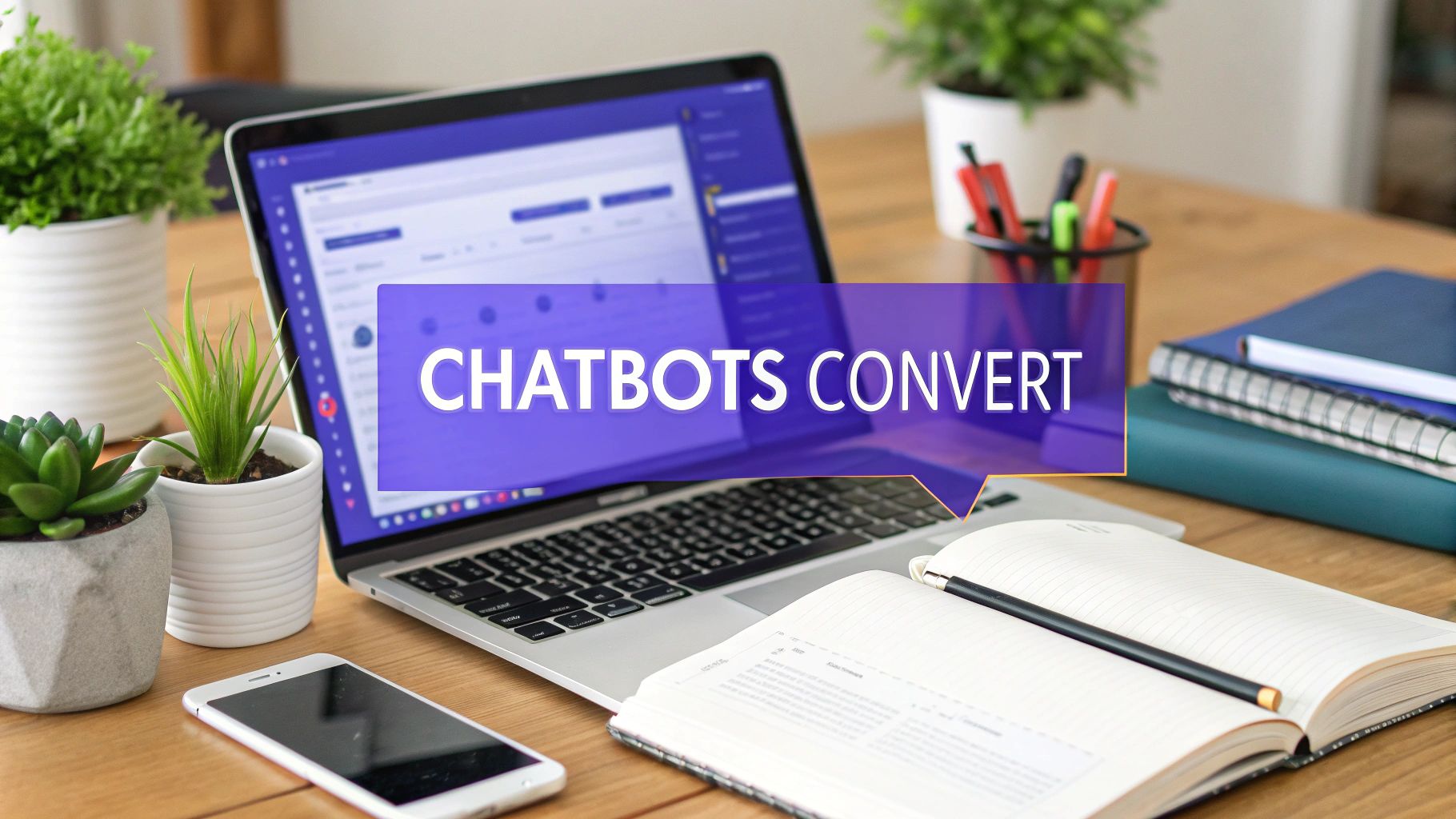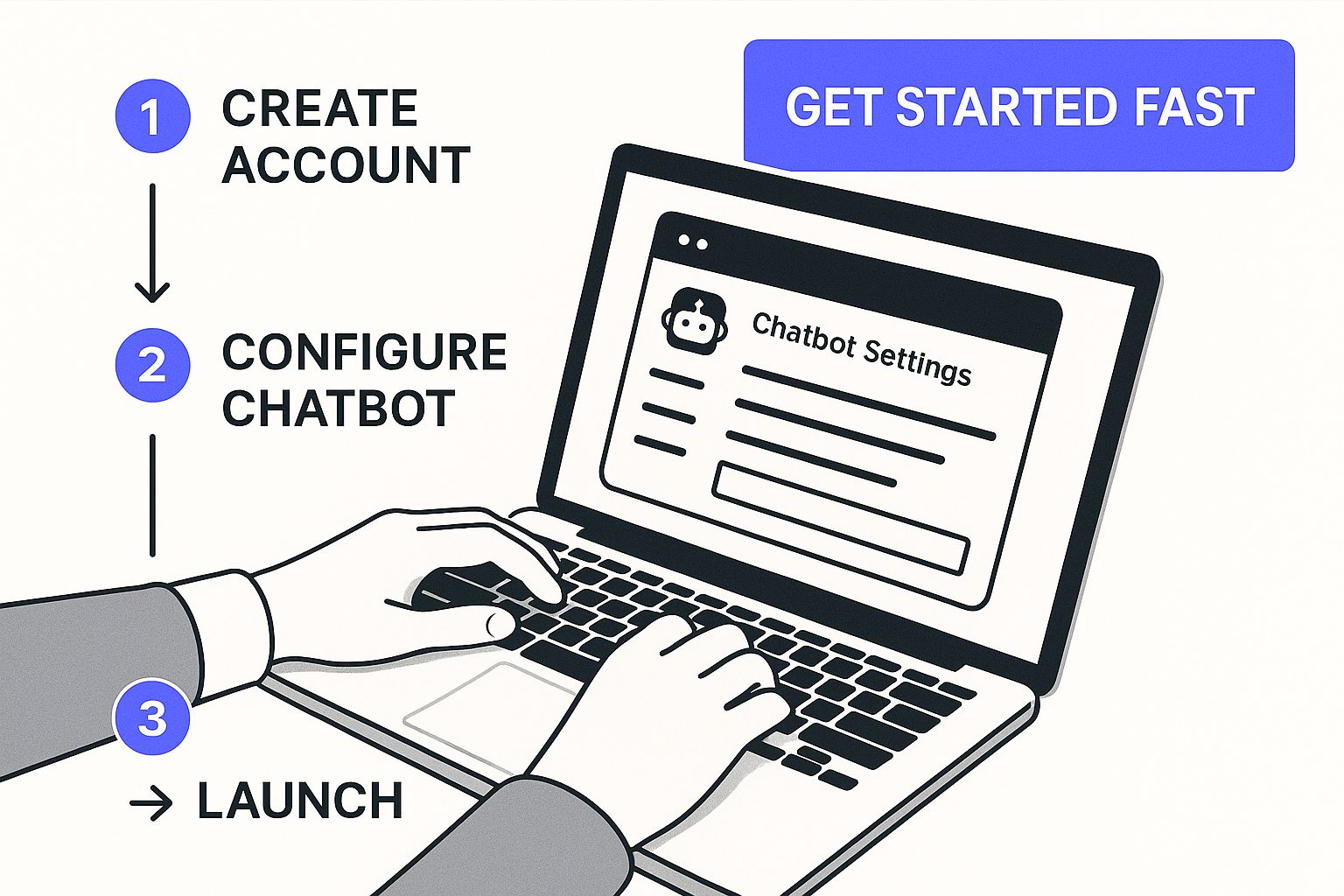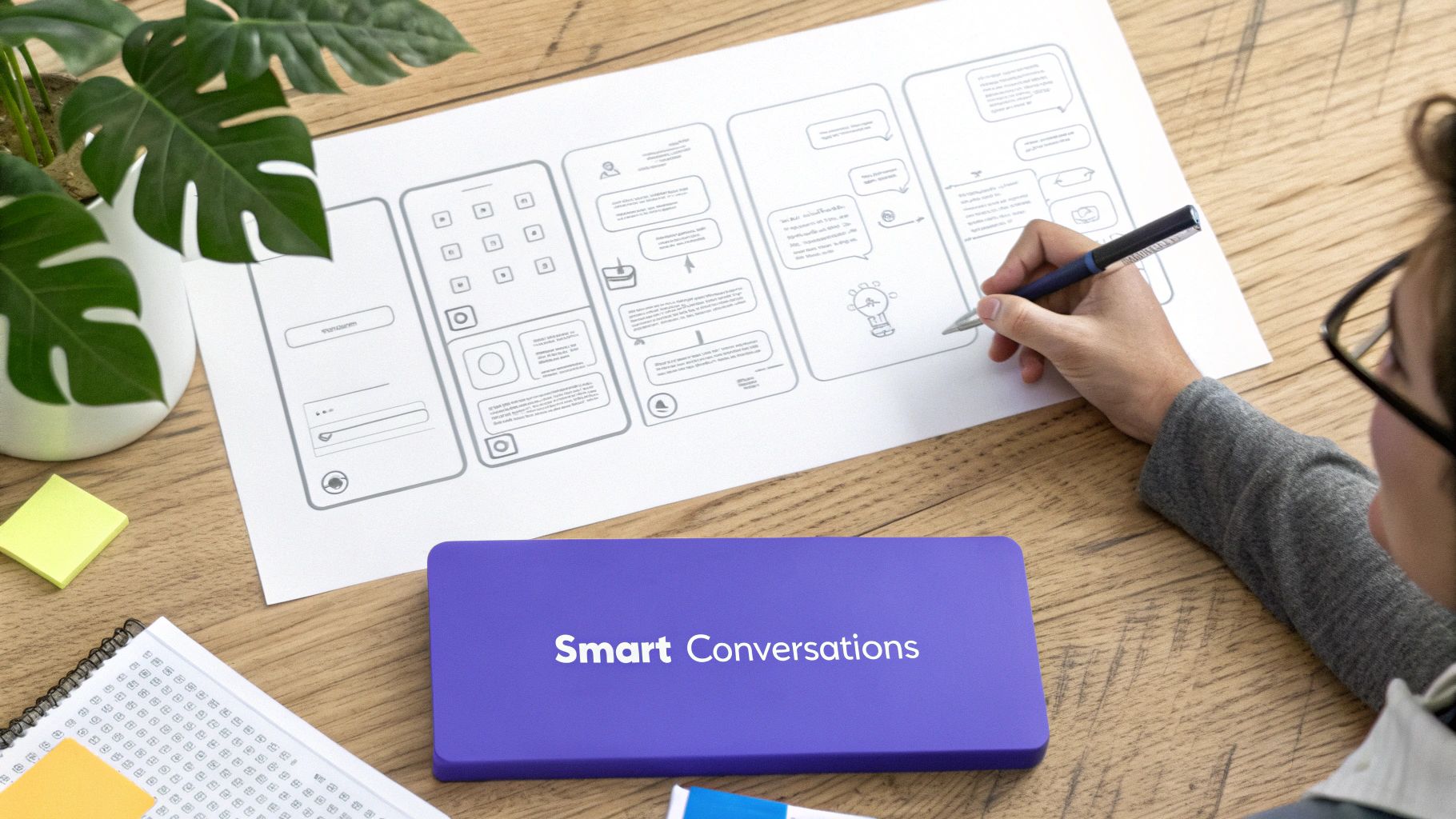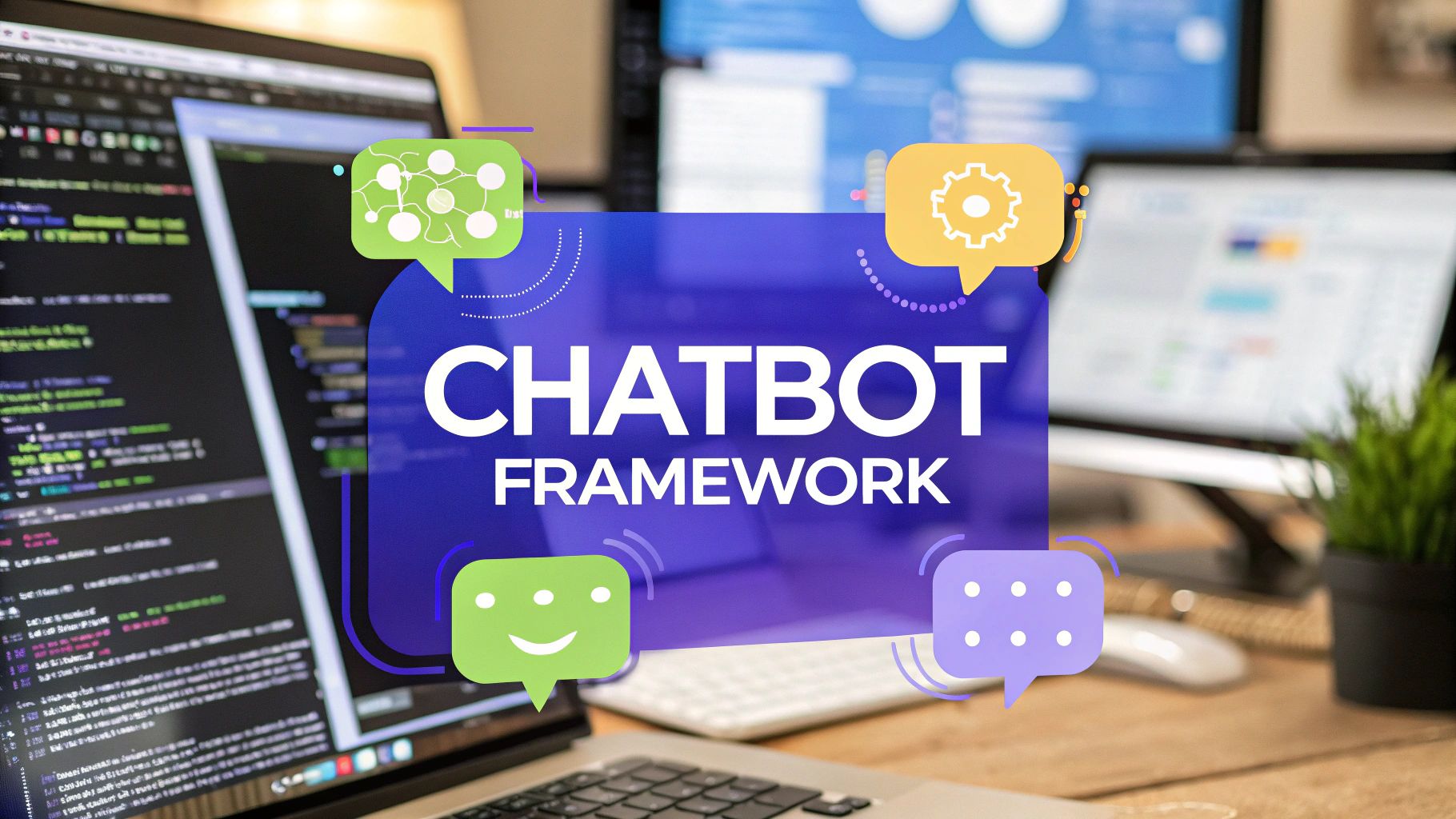Using Chatbots for Lead Generation That Convert
Discover how to use chatbots for lead generation to capture qualified leads. Learn practical strategies for setup, conversation design, and optimization.

Tired of watching website visitors click away without leaving their details? If your lead generation strategy still uses a static "Contact Us" form, you're leaving money on the table. Chatbots for lead generation offer a live, interactive way to engage people the moment they land on your site, turning passive browsing into active conversation.
Unlike slow, old-school forms, a chatbot gives visitors immediate, 24/7 help. That alone can make a huge difference in your conversion rates.
How Chatbots Transform Website Lead Capture
Think about the typical "Contact Us" page. It puts all the work on the potential customer. They have to find the page, fill out a bunch of fields, and then wait, hoping someone gets back to them eventually. It's a passive approach that completely fails to capture a visitor's immediate interest.
Chatbots flip that model on its head. They proactively start helpful conversations, guiding visitors and answering questions in real time. This immediate, two-way interaction is a massive advantage over the "send it and forget it" experience of a form submission.
Engage and Qualify Leads Instantly
A well-designed chatbot does more than just say hello. It asks smart, targeted questions to figure out what a visitor needs and whether they're a good fit for your business.
Think of it as a friendly digital concierge on your site. It can ask about:
- The specific challenges or goals they're trying to solve.
- Their budget or timeline for a project.
- The size of their company or team.
This conversational approach gathers vital information naturally, without making the user feel like they're being interrogated. Chatbots are a game-changer for demonstrating how to automate lead generation and making your website's lead capture process far more efficient.
This method is so effective because it filters and qualifies leads before they ever reach your sales team. Your team can stop wasting time on tire-kickers and focus their energy on conversations with people who are genuinely interested and ready to move forward.
The data backs this up. In fact, leads generated through chatbots often convert to customers at three times the rate of leads from traditional forms. It just goes to show how powerful immediate engagement and qualification really are for your sales cycle.
Chatbot vs. Traditional Form Lead Capture
Let's break down the real differences between chatbots and the old-school static forms that most websites still rely on. While forms are just a one-way street for collecting data, chatbots create a dynamic, two-way dialogue that feels more human and helpful.
The table below gives you a quick side-by-side comparison.
By meeting visitors where they are and offering instant value, chatbots don't just collect more leads—they collect better leads. This shift helps your sales team become dramatically more productive by letting them focus only on high-potential prospects who are already warmed up and qualified.
Your First Steps in Setting Up a Lead Gen Bot
Getting a chatbot live on your site probably sounds like a job for a developer, but platforms like Chatiant have made the whole process surprisingly straightforward. You can get a solid lead generation bot up and running in less than an hour, even if you have zero coding background. The trick is to start with the basics and build from there.
Your first move is to create an account and pick a starting point. Most modern chatbot builders offer pre-built templates designed specifically for lead generation, which means you don’t have to build a conversation from the ground up. These templates already have a basic flow for greeting visitors and asking for contact info.
Choosing a Template and Customizing the Look
Once you're logged in, you’ll see a bunch of pre-built options. Look for anything labeled "Lead Generation," "Sales," or "Book a Demo." This gives you a solid foundation to work from.
From there, you can start tweaking the bot's appearance. Think colors, fonts, and even the avatar. The goal is to make it match your company's branding, because a chatbot that looks like it belongs on your site just feels more trustworthy to visitors.
This is what a typical setup interface looks like, showing just how quickly you can get moving.

As you can see, modern platforms are all about a fast, user-friendly setup. This lets you focus on crafting the right conversation, not getting bogged down in complex configurations.
Next, you need to decide on the bot's one true purpose. Is it here to book meetings? Collect email addresses for your newsletter? Or is it meant to qualify visitors before handing them off to a sales rep? Having a clear goal is the single most important part of the setup.
A chatbot without a specific objective is just a distraction. Your goal should be singular and measurable, like "Increase qualified demo requests by 15%" or "Capture 50 new marketing leads per week." This focus will guide every decision you make about its conversation flow.
After you've defined the goal, it's time to craft a compelling welcome message. This is the first thing a visitor sees, so it needs to be engaging and immediately clear.
So, what should a good welcome message do?
- Grab attention: A friendly greeting or a simple question works wonders.
- State its purpose: Let people know it's a bot and how it can help (e.g., "I can answer your pricing questions or book a demo for you.").
- Provide a clear call-to-action: Give the user buttons or quick options to get the ball rolling.
Deploying Your Bot on High-Intent Pages
Here's a pro tip: you don't need to put your chatbot on every single page of your website. In fact, you shouldn't. Be strategic about it. Place it on the pages where visitors are most likely to be thinking about becoming a lead.
Think about high-value spots like:
- Your Pricing Page
- Specific Product or Service Pages
- The Contact Us Page
- High-traffic Blog Posts that are closely related to your solution
By targeting these high-intent areas, your chatbot engages people who are already showing strong interest in what you offer. This targeted approach dramatically improves the quality of the chatbots for lead generation you collect, making sure your sales team is talking to the most promising prospects.
Designing Conversations That Actually Convert

A high-performing chatbot does more than just ask for an email. It’s designed to guide a visitor through a helpful, natural conversation that builds trust while collecting the key info your sales team needs. The real secret is in the flow.
You can't just drop a visitor into a series of questions and hope for the best. The interaction needs a clear beginning, middle, and end. The goal is to make the experience feel less like a quiz and more like a helpful consultation.
Start with a Strong Opener
The very first message from your bot sets the entire tone. A weak opening will get your chat window closed almost immediately. A strong one grabs attention and makes the visitor want to engage.
Your opener should do two things, and do them fast:
- Clarify its purpose: Let the user know it's a bot and what it can help with. Something like, "Hi there! I'm the Chatiant assistant. I can help you find the right plan or book a quick demo. What can I help you with today?" works perfectly.
- Offer clear next steps: Give them buttons like "See pricing," "Book a demo," or "Ask a question." This gets rid of any friction and kicks off the conversation without making them think too hard.
This initial step is all about making the visitor feel in control and showing them the bot is there to provide value, not just take their information.
Blend Question Types to Keep Users Engaged
Once the conversation is flowing, you need to gather information without making it feel like an interrogation. A classic mistake is hitting them with a wall of open-ended questions. This forces them to type a lot and is a surefire way to make them abandon the chat.
A much better approach is to mix up your question types.
The most effective chatbots for lead generation alternate between simple multiple-choice questions and occasional open-ended ones. This creates a balanced, low-effort experience that keeps the user moving forward.
For example, you could start with easy, multiple-choice questions to qualify the lead. These are just quick taps for the user and give your sales team clean, structured data to work with.
Example Lead Qualification Questions:
- What is your primary goal today? (Buttons: Get Pricing, Book a Demo, Technical Support)
- What is your team size? (Buttons: 1-10, 11-50, 51+)
- What is your approximate monthly budget for this project? (Buttons: <$500, $500-$2000, >$2000)
After you've gathered some of the basics, you can slip in an open-ended question to get more specific context. For instance, after they select a team size, you might ask, "Great, thanks! And what's the biggest challenge you're hoping to solve?" This gives them a chance to explain their needs in their own words.
Crafting this logical sequence of questions is what turns a simple chat into a powerful lead-gen machine. For a closer look into structuring these interactions, you can learn more about perfecting your chatbot conversation flow design. By carefully mapping out each step, you create an experience that feels genuinely helpful and guides visitors smoothly from prospect to qualified lead.
Connecting Your Chatbot with Your Sales and Marketing Tools
Capturing a lead is just the first domino to fall. The real power of chatbots for lead generation kicks in when they talk seamlessly with the software you already use every day. Without that connection, your chatbot is basically collecting names on a digital island, forcing you to manually copy and paste data. This process is slow and full of opportunities for mistakes.
This is where integrations save the day. By linking your chatbot to your Customer Relationship Management (CRM) system or email marketing platform, you create an automated workflow that sends fresh, hot leads directly to your sales team. This immediate handoff means follow-up can happen in minutes, not hours or days.
Automating the Lead Handoff
Picture this: a visitor is on your website, has a great conversation with your bot, and gives their name, company, and email. They even ask to book a demo. With the right integration, all that information is instantly pushed to your CRM.
A new contact pops up in a system like HubSpot or Salesforce, and a task is automatically assigned to a sales rep. This completely wipes out manual data entry. More importantly, it slashes the time it takes for your sales team to act on a promising lead. Did you know a five-minute delay in follow-up can crater your chance of qualifying a lead by 80%? Speed is everything.
Here are some of the most common connections you’ll want to set up:
- CRM Integration: Automatically create new leads or contacts in platforms like Salesforce, HubSpot, or Zoho CRM.
- Email Marketing Integration: Add new subscribers to lists in Mailchimp or ConvertKit to kick off welcome email sequences.
- Calendar Integration: Let qualified leads book meetings directly on your sales team's calendar using tools like Calendly.
The core idea is to make your chatbot the starting point of an automated process, not the end point. This makes sure no lead falls through the cracks and your team can focus on selling, not on administrative tasks.
Triggering Personalized Follow-Up Actions
Connecting your tools also unlocks the ability to create much more sophisticated, personalized follow-up campaigns. When a chatbot sends lead data over to your marketing automation software, it can include specific details from the conversation, like the visitor's pain points or the products they showed interest in.
This rich context can be used to trigger highly relevant email nurture sequences. For example, if a lead mentioned they were interested in "e-commerce solutions," your system can automatically send them a case study about how you helped another online store.
To truly get the most out of your chatbot, you’ll want to integrate it within a broader ecosystem of lead generation automation tools. When all these systems work together, they can streamline your entire capture-to-close process.
To get these integrations up and running, platforms like Chatiant often use webhooks or an API. Think of these as messengers that allow different software applications to talk to each other. You can get more details on how this works by checking out our guide on using an API for chatbot connections. This is the technical magic that lets your bot instantly push lead data to where it needs to go, making your entire sales operation faster and way more efficient.
How to Tune Your Chatbot for B2B vs. E-commerce

Let's be clear: a one-size-fits-all chatbot is a recipe for failure. The strategy that lands a huge client for a software company will completely miss the mark for an online fashion boutique. You have to design your chatbot’s conversation flow for your specific business model.
For B2B companies, the name of the game is qualifying high-value leads for a longer, more considered sales cycle. Over in e-commerce, it’s all about driving immediate sales and giving shoppers instant answers.
B2B Chatbot Strategies: The Smart Filter for High-Value Leads
In the B2B space, your chatbot’s most important job is to act as an intelligent filter. It’s there to separate the curious browsers from the serious buyers, which frees up your sales team to focus on deals that matter.
Instead of just grabbing an email and calling it a day, a smart B2B chatbot engages in a qualification dialogue.
Imagine a chatbot for a professional services firm. It might ask about company size, the visitor's role, or their biggest operational headache. That’s not just small talk; it's useful data that helps score the lead before it ever lands in a human’s inbox.
Here are a few things effective B2B chatbots do really well:
- Booking Demos: The bot can tap directly into a sales rep’s calendar to schedule a product demo, killing the endless back-and-forth emails that everyone hates.
- Answering Tough Questions: By training the bot on your technical docs, it can provide instant, detailed answers on complex product features or security protocols.
- Gating Valuable Content: A bot can offer a whitepaper or case study in exchange for a business email, qualifying the lead's interest while delivering value.
The goal for a B2B chatbot isn’t just to get any lead; it's to get a qualified lead. Think of it as an always-on sales development rep, making sure your team only talks to prospects who are a genuine fit.
E-commerce Chatbots: Your 24/7 Sales Assistant
For e-commerce stores, the path from conversation to conversion is much, much shorter. Here, chatbots for lead generation are less about lead scoring and more about directly nudging a visitor toward a purchase.
The conversations are all about helping shoppers and removing any friction from the buying journey.
These bots are fantastic at offering up personalized product recommendations based on a few simple questions. For example, a bot might ask, "Are you shopping for a gift or for yourself?" and then suggest relevant products. This kind of guided selling can give your conversion rates a serious lift.
The data backs this up. A whopping 77% of the most successful lead generation chatbots are used by e-commerce stores. It’s clear this sector is all-in on chatbots, which makes perfect sense given the immediate impact they can have on the bottom line.
A few other powerful e-commerce chatbot tactics include:
- Abandoned Cart Recovery: If a user is lingering on the checkout page, a bot can pop up with a discount code or offer to answer a last-minute question to save the sale.
- Shipping Updates: Customers can ask the bot for their order status on demand, freeing up your support team to handle more complex issues.
By personalizing the conversation, a well-designed bot can completely change your online store's customer experience. To go even deeper, check out our complete guide on using a chatbot for ecommerce to drive sales and keep customers coming back.
Common Questions About Lead Generation Chatbots
As you get ready to add a chatbot to your website, a few questions are bound to pop up. It's totally normal. Let's tackle some of the most common ones we hear from businesses just starting out with chatbots for lead generation.
Aren't Chatbots Just Glorified Forms? How Are They Better at Qualifying Leads?
Not at all. Think of it this way: a form is a one-way street. It just sits there, passively collecting whatever information a visitor decides to give. A chatbot, on the other hand, creates a real, two-way conversation.
Because it's interactive, a chatbot can ask specific, targeted questions based on a visitor's previous answers.
For example, a bot can find out a person's job role, company size, budget, and their biggest pain points—all within the chat itself. This active questioning lets the bot score the lead in real time. It can even route high-value prospects directly to a live sales agent for an immediate conversation, giving your team leads who are warmed up and ready to talk business.
Will a Chatbot Feel Too Robotic to Our Visitors?
That's a valid concern, but modern chatbots can be designed to feel surprisingly natural. The key isn't to trick people into thinking they're talking to a human. The best approach is being upfront that it's a bot while giving it a friendly personality that matches your brand's voice.
You can easily use casual language, emojis, or even GIFs to make the interaction more engaging and human-like.
The goal is to offer a fast, helpful, and efficient experience. When a chatbot helps someone solve a problem or find an answer in seconds, most people appreciate the interaction, bot or not.
With All the Data Chatbots Collect, What’s the Most Important Metric to Track?
While there are plenty of chatbot analytics you can get lost in, the single most important metric to watch is the lead qualification rate.
This number tells you the exact percentage of chatbot conversations that result in a lead meeting your specific criteria. For instance, you might define a qualified lead as someone who provides a work email, requests a demo, or confirms they have a budget over a certain amount.
Watching this metric directly measures how well your chatbot is doing its primary job. More importantly, it helps you fine-tune your conversation scripts to get not just more leads, but more of the right leads.
Ready to build a smart chatbot that captures and qualifies leads for you 24/7? Get started with Chatiant and create your first AI agent trained on your own data in just minutes. Explore the platform and see how easy it is to automate your lead generation at https://www.chatiant.com.


